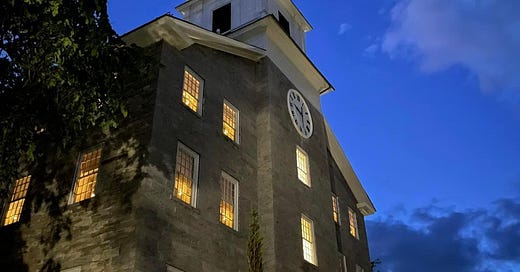Few things make you feel how entropy works more than a college reunion, when time plays its sweetest and sometimes most heartbreaking tricks. We inhabit our current, older, bodies but with young souls newly summoned up by memories and reminiscence. There’s no hiding the passage of time—and even if we tried, our classmates would see right through us—but all the same, we do lose a few years over a reunion weekend simply by being in such close contact with our younger lives. We do leave a reunion rejuvenated.
In a panel discussion with three writer classmates, I ended up talking about entropy, offering it as part of my answer to the question: why do I write. After hearing the eloquent and powerful responses of my fellow panelists—who spoke about the urge to write for the unrepresented, who spoke about the desire to address an inherent human loneliness—I said a few things about entropy and beauty. I’ve been thinking about my answer since then and want to take this newsletter as a second chance to write about how these two things—entropy and beauty—come together, I think, in the attempt to create art.
Entropy. That’s the easy part. We are always, every second, growing older. Like our universe, we are moving ever into greater disorder and greater decay. This is a fact of our existence. Even the richest human experience is, by nature, an experience of loss. This isn’t exactly the kind of relive-our-halcyon-days talk one would expect at a reunion. But I’m pleased to say my class responded to my statements with laughter—laughter that was more knowing than nervous.
Beauty. The way I see it, every time we make art, we are trying to share with someone else what we think is beautiful. As a writer, I think this is essentially true of every sentence, not just the ones whose content is actually beautiful. Even when we are, say, writing about disgusting behavior or a disgusting object, we’ve crafted our sentences with beauty in mind. Eloquence, power, impact: yes, sure, these are the specifics we aim for. But in essence, it comes down to beauty. I often feel as though when I share my work, I am holding out this thing I made and saying, here, look at this because I think it’s beautiful. And if you think it’s beautiful, too, then we will have found some kind of deep bond between us.
We create because we wish to connect. But we also create in the face of the fact of entropy. Because our world is growing cold, because life is an experience of loss, we gather and shape and savor what is beautiful. Tom Stoppard has said this perfectly in his play Arcadia:
We shed as we pick up, like travelers who must carry everything in their arms, and what we let fall will be picked up by those behind. The procession is very long and life is very short. We die on the march. But there is nothing outside the march so nothing can be lost to it.
Stoppard casts loss as individual not universal. What one individual loses through the course of a life becomes a gain for someone else. Our lives, no matter what, enrich the lives of those after us.
I think that all of us, whether we create art or not, leave something behind that has our mark on it, our stamp. We’ve all created something. Those of us who try to create art through its recognized (or not-yet-recognized) forms are making our offerings of beauty.
So, why do I write? Because by sharing with someone what I think is beautiful, I just might stave off—even just a little, even if it’s ultimately impossible—our slide into disorder.
What’s your answer to the question of why you write? Or perform the art you do?
What do you do to create beauty?
What do you do to stave off entropy?






Because I know life is beautiful, even when it’s ugly and cold and awful, and all the goodness and love I counted on seem to have disappeared.